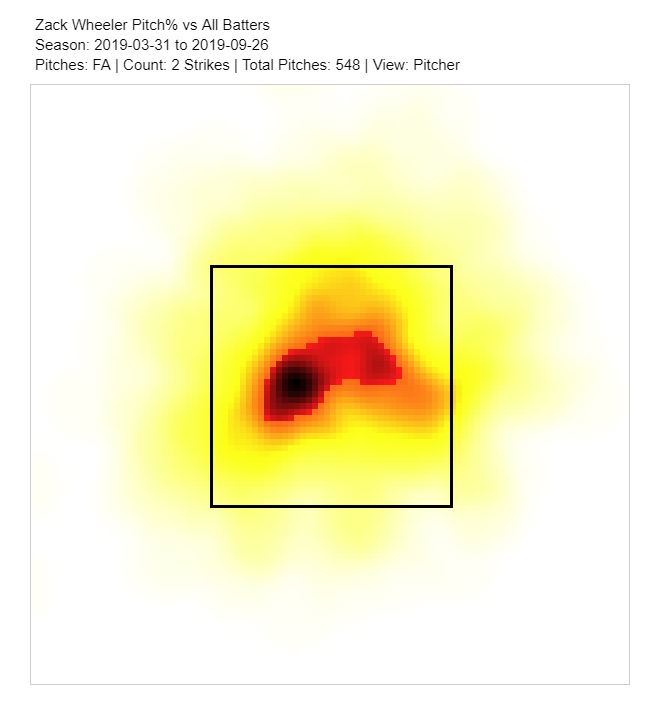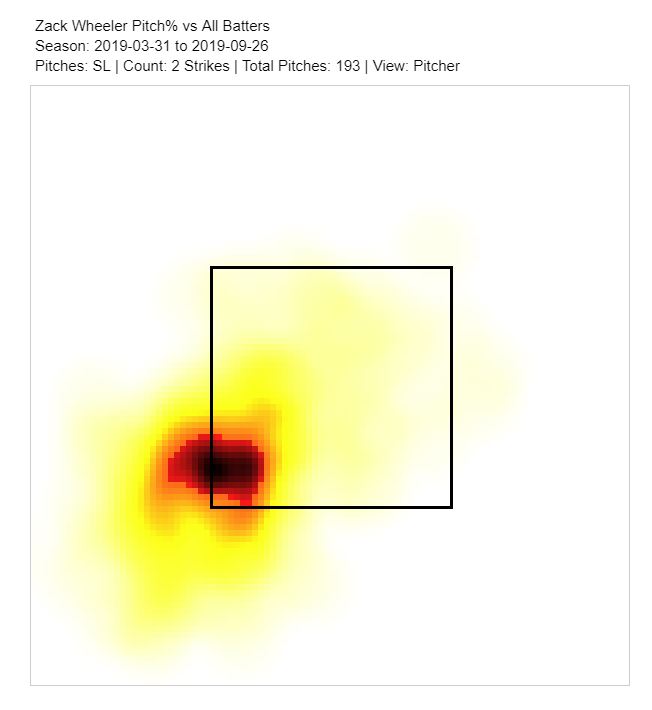Zack Wheeler is Good, But Not as Good as He Could Be
Any day week month now, Zack Wheeler is going to sign a contract that compensates him like a very good pitcher, and he’ll deserve it. He’s been consistently above average the past two years, the kind of guy you’d love to have as a No. 2 starter and one who can fake it as a No. 1. In short, he’s been what the Mets hoped for when he was a highly regarded prospect, after a brief detour into arm-injury-land.
But I think there’s still more there. Zack Wheeler, as currently constituted, does everything a bit better than average. He strikes out a few more batters than average, walks a few less, and suppresses hard contact just a smidge. That makes for an above-average pitcher, of course. But it doesn’t make for a world-devouring ace, the kind who opposing batters fear and hometown fans assume will never lose.
In 2019, Wheeler struck out 23.6% of the batters he faced, which placed him 45th among pitchers who threw at least 100 innings last year. That’s high enough to be effective, especially considering his excellent walk rate — Zack Greinke, Hyun-Jin Ryu, and José Berríos all posted lower K% and were All-Stars — but it’s a rate with plenty of room for improvement.
It’s also a surprising number in light of Wheeler’s arsenal. His fastball sits around 97 mph, and he’s topped out above 100 mph in each of the past two years. He throws it with more horizontal break than your average four-seamer (it has three more inches of horizontal break and one less of vertical break than Jacob deGrom’s four-seamer), but gets excellent movement nonetheless.
His slider also conjures images of deGrom. It’s the second-fastest slider among starters, behind only deGrom’s, and it has a similar movement profile — just enough glove-side break to matter, more a cutter than a pure slider, and sneaky rise relative to what batters look for in a slider. He complements those two with a hard, two-plane curveball and a changeup he throws almost exclusively to lefties, often replacing his slider.
If you just watch each of those pitches produce whiffs, it’s hard to tell Wheeler is anything less than monstrously good. Watch him eat Bryce Harper alive with a casual, low-effort 99 mph fastball on the high outside corner:
Think that’s good? Watch him consume a part of Juan Soto’s soul on live television:
The curve doesn’t have quite the nasty snap of the slider, but it makes up for it in depth:
And what the heck, let’s bring Harper back one more time, even though Wheeler’s changeup isn’t quite as spectacular as his other three offerings:
But Wheeler can struggle to turn these four dynamic pitches into strikeouts. Some of this comes down to the fact that while each of his pitches looks a lot like deGrom’s, none of them are as good. His whiff rates are lower across the board, and he doesn’t generate as many chases. But some of it is harder to pin down. Wheeler simply doesn’t get the strikeouts he should from his stuff.
The first place I look when results underperform stuff is first-pitch strike rate. Baseball is increasingly a game of strikeouts and loud contact, which makes getting to situations where a strikeout is more likely incredibly valuable. Batters put up a 64 wRC+ after an 0-1 count, as compared to a 126 wRC+ after getting ahead 1-0. They struck out 31% of the time after 0-1, and only 18.6% of the time after 1-0. Is Wheeler just getting behind in the count?
Nope! In fact, he’s excellent at getting first-pitch strikes. He does it by filling the zone — he throws in the strike zone on 56% of his first pitches, comfortably above league average. That results in more swings, and more balls in play, than average, but also gets him ahead in the count more often than not.
Where Wheeler falters is after getting ahead. Two strike counts should be a ticket to strikeouts when you have stuff like his. Flash that fastball high in the zone, or snap off a curve or slider outside of it, and you stand a good chance of getting batters to swing. And Wheeler gets strikeouts — he struck out 50% of batters who got behind in the count 0-2 against him, a bit better than league average, and 31.5% after getting ahead 0-1, which is roughly average.
But roughly average isn’t where Zack Wheeler should be. Look again at those pitches up above. Now, reconcile that with the fact that Wheeler was 62nd among starters in strikeout rate after getting ahead 0-1. Other counts aren’t much better for him; he was 37th in K% after 0-2, 92nd after 1-2, and 68th after 2-2. What gives?
Problems like this are always complex, but in Wheeler’s case, I can point to one thing that’s certainly contributing. Two strike counts are an interesting sub-game within baseball — for hitters, contact is at a premium, because it gets them out of a bad situation, while for pitchers, avoiding contact is a must. Excluding full counts, a pitch out of the zone taken for a ball isn’t as bad for a pitcher as a swing on a pitch in the zone. As fastballs (of the two- and four-seam varieties) are the easiest pitches to put in play, and also generate the fewest chases, pitchers steer clear of them with two strikes, throwing them only 46.5% of the time.
But Wheeler isn’t like the other pitchers. With two strikes, he threw a fastball 55.9% of the time. He throws more fastballs in every count, which contributes to this somewhat, but also doesn’t decrease his fastball usage as much as the rest of the league. This works out about how you’d expect — more contact, fewer whiffs.
Now, you can still strike batters out with fastballs. Prolific strikeout pitchers use two-strike fastballs for a specific purpose: getting swings and misses high in the zone. We’ve been using deGrom as a comparison for Wheeler, so let’s continue here. Take a look at where he locates his fastball in two strike counts:

That’s how you use your fastball to finish batters off — by climbing the ladder when batters are predisposed to swing. How does Wheeler locate his fastballs in the same situation? Well, to use a technical term, yikes:

Wheeler excels at the hard work of getting ahead in the count. That’s the difficult part! When he gets there, though, he too often chooses the wrong pitch. Even if he insisted on sticking with fastballs, he could make up for it by elevating — but he doesn’t do that either. Instead, he gives batters what they want — a hittable pitch in a friendly location.
To make matters worse, Wheeler has an excellent two-strike offering. He uses his slider to attack the low gloveside corner, an ideal location. This is where you want your two strike pitches:

There’s more to it than that, of course. Wheeler probably couldn’t drop his fastball usage by 10%, turn those pitches into sliders, and suddenly strike out 30% of the batters he faces. Pitching doesn’t take place in a vacuum, and batters can adjust. He probably can’t just start hitting the upper edge of the strike zone with his fastball more often. If he could do that, he already would be.
But whatever team signs Wheeler will be trying to make him better, and this is absolutely one way he could improve. Kiley McDaniel projected a four-year, $68 million contract for Wheeler, and I would err towards a larger deal rather than a smaller one. But whether he gets that or something closer to Patrick Corbin money (six years and $140 million, but back-loaded), he could make the deal look like a bargain by taking a step forward, and the easiest place for him to do that is his strikeout rate.
Baseball is rarely as easy as throwing more breaking pitches and fewer fastballs. But in Wheeler’s case, despite his blazing heater, it just might be. And next year, some team will be hoping for a few tweaks just like this to help Wheeler take the leap from above average to superstar.
Ben is a writer at FanGraphs. He can be found on Bluesky @benclemens.

As good as Wheeler has been the past two years, and as much room for improvement as he still seems to have, it’s mind-blowing how many people are suggesting he might accept the QO- or that it will affect his ability to get a good contract.
I don’t think it will affect his ability to get a good contract–certainly, the contract projected by Kiley is a good contract–but the QO will probably have some dampening effect when combined with the fact that he’s only the third best pitcher on the market right now. Without the QO and Cole/Strasburg around, he’s probably looking at Yu Darvish money. With those two, he’s probably somewhere between Eovaldi and Samardzija (who, incidentally, had the same AAV, just different lengths. And the AAV is the same as the QO).
You’re right, it probably will have some sort of dampening effect on the contract- but I feel like I am seeing a lot of (non-media) commenters suggesting that he will linger until after the draft, like Keuchel- which feels hard to imagine. Keuchel was a guy who seemed to be on the downswing last year, whereas Wheeler is younger and seems to have some remaining upside (as suggested by this article).
True. Keuchel’s low-K/high-GB style leaves very little room for upside and a lot of room for downside. Stroman is the same way.
Well, if Wheeler is adamant that he wants to be paid like Jon Lester or Patrick Corbin or something and refuses to budge, that probably will happen. I’m not sure any of the players who got the QO aside from Abreu are going to see their market destroyed by it all by itself (although in Abreu’s case, the QO is a great deal for him). But if I had to bet, I’d say it the guys who should be worried more are Odorizzi (whose success was partly due to suppressing home runs despite a lot of fly balls) and Ozuna (because non-elite position players are always at risk of getting frozen out). But even those guys could very well be fine.